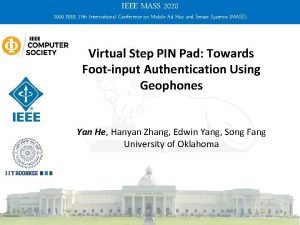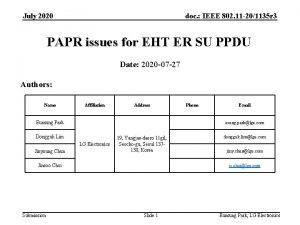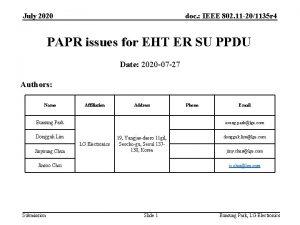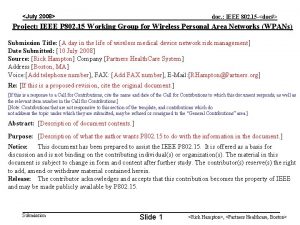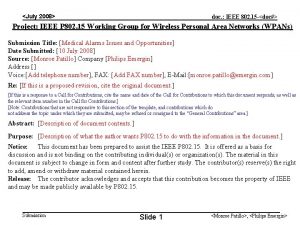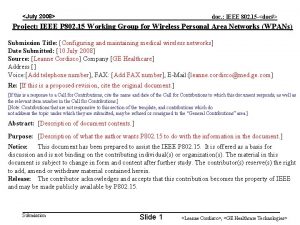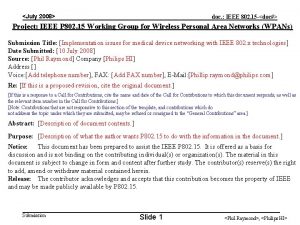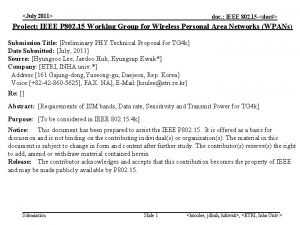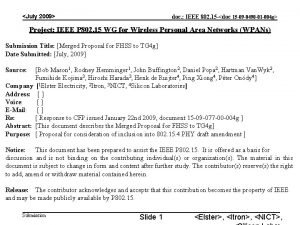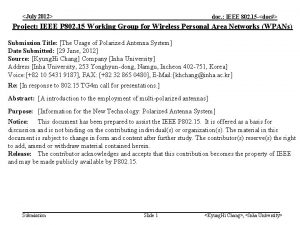July 2020 doc IEEE 802 11 201135 r











![July 2020 doc. : IEEE 802. 11 -20/1135 r 5 References [1] 802 -11 July 2020 doc. : IEEE 802. 11 -20/1135 r 5 References [1] 802 -11](https://slidetodoc.com/presentation_image_h2/6ca0f2c9dae8e5be47238c08b9581c20/image-12.jpg)
- Slides: 12

July 2020 doc. : IEEE 802. 11 -20/1135 r 5 PAPR issues for EHT ER SU PPDU Date: 2020 -07 -27 Authors: Name Affiliation Address Eunsung Park LG Electronics 19, Yangjae-daero 11 gil, Seocho-gu, Seoul 137130, Korea Jinsoo Choi Submission Email esung. park@lge. com Dongguk Lim Jinyoung Chun Phone dongguk. lim@lge. com jiny. chun@lge. com js. choi@lge. com Slide 1 Eunsung Park, LG Electronics

July 2020 doc. : IEEE 802. 11 -20/1135 r 5 Introduction • To extend the transmission range of the low power indoor Wi-Fi system in 6 GHz, a new type of PPDU (EHT ER SU PPDU) was introduced in [1][2] – Data part is duplicated in the frequency domain for the non-punctured 80/160/320 MHz SU transmission – Only BPSK with DCM is used • This frequency-duplicated data part leads to an increase in PAPR – It may be a harmful issue when EHT ER SU PPDU is used for the outdoor support – It may also cause a problem for STAs which only support indoor usage cases in 6 GHz • In this contribution, we propose a simple method to reduce the PAPR of the data part in EHT ER SU PPDU Submission Slide 2 Eunsung Park, LG Electronics

July 2020 doc. : IEEE 802. 11 -20/1135 r 5 PAPR Issue (1/2) • For STAs which support both indoor and outdoor environments in 6 GHz, a PAPR increase due to the frequency-duplicated data part may cause a problem if this PPDU is used for outdoor cases – For the low power indoor transmission, it is highly probable that PA operates within a linear range that means a little increase in PAPR for this low power mode may not cause a critical problem – However, for the outdoor support where high power is used for the transmission, this increased PAPR can cause severe signal distortion, and thus, we need a decent method to reduce the PAPR Submission Slide 3 Eunsung Park, LG Electronics

July 2020 doc. : IEEE 802. 11 -20/1135 r 5 PAPR Issue (2/2) • On the other hand, there are many devices used only for the indoor environment these days, and in this case, high PAPR may also need to be treated – Various home appliances are equipped with a Wi-Fi system to provide smart home services – Io. T services are also prevalently used in many offices through Wi-Fi connection – In these STAs, hardware can be implemented considering only the indoor support which results in cost reduction • Considering the low power indoor in 6 GHz, hardware requirement can be relaxed, e. g. , 1 d. B compression point of PA can be a low value – In this case, PAPR reduction may be beneficial for the hardware implementation as well as the performance (PER, throughput, etc. ) Submission Slide 4 Eunsung Park, LG Electronics

July 2020 doc. : IEEE 802. 11 -20/1135 r 5 Options for Duplication • We introduce two options for the duplication of the data part in the frequency domain for EHT ER SU PPDU – Option 1: simple duplication Data* Duplicated Data Frequency domain – Option 2: duplication + phase rotation of 180° (multiplied by -1) at the last (option 2 a) / first (option 2 b) half of the channel in duplicated data part Data* Duplicated Data* Multiplied by -1 Duplicated Data Multiplied by -1 • For 80 MHz EHT ER SU PPDU, 484 -tone RU is duplicated and the highest (2 a) / second highest (2 b) 20 MHz subchannel is multiplied by -1 • For 160 MHz EHT ER SU PPDU, 996 -tone RU is duplicated and the highest (2 a) / second highest (2 b) 40 MHz subchannel is multiplied by -1 • For 320 MHz EHT ER SU PPDU, 2 x 996 -tone RU is duplicated and the highest (2 a) / second highest (2 b) 80 MHz subchannel is multiplied by -1 *Data is generated by BPSK with DCM Submission Slide 5 Eunsung Park, LG Electronics

July 2020 doc. : IEEE 802. 11 -20/1135 r 5 PAPR (1/2) • 80 MHz QAM: non-duplicated random data with QPSK BPSK: non-duplicated random data with BPSK w/ DCM: non-duplicated random data with BPSK w/ DCM For option 1, 2 a and 2 b, data is modulated using BPSK w/ DCM, and then, duplicated Simple duplication method (option 1) increases PAPR by about 2 d. B compared to the nonduplicated case with BPSK w/ DCM With the proposed phase rotation methods (option 2 a and 2 b), PAPR can be significantly reduced (even lower than the non-duplicated case with BPSK) Option 2 a and 2 b have almost the same PAPR Submission Slide 6 Eunsung Park, LG Electronics

July 2020 doc. : IEEE 802. 11 -20/1135 r 5 PAPR (2/2) • 160 MHz • 320 MHz Trend is similar to the 80 MHz frequency-duplicated transmission Submission Slide 7 Eunsung Park, LG Electronics

July 2020 doc. : IEEE 802. 11 -20/1135 r 5 Conclusion • We have discussed PAPR issues for EHT ER SU PPDU which was introduced to enhance the coverage of the low power indoor Wi-Fi system in 6 GHz – EHT ER SU PPDU can be also used for the outdoor case where a high power transmission is assumed, and in this case, PAPR reduction may be necessary – On the other hand, there are many devices only used in the indoor environment, and, in this case, increased PAPR may also be a problem due to cost-efficient hardware design • To reduce the PAPR for EHT ER SU PPDU, we have proposed to apply the phase rotation to the last / third quarter of the channel in the data field – We have verified that these methods achieve considerable reduction in PAPR and even have lower PAPR than the non-duplicated case modulated with BPSK Submission Slide 8 Eunsung Park, LG Electronics

July 2020 doc. : IEEE 802. 11 -20/1135 r 5 Straw Poll #1 • Which option do you prefer? – Option 2 a: the last quarter of the channel in the data field is multiplied by 1 – Option 2 b: the third quarter of the channel in the data field is multiplied by -1 – Abstain – This is not intended for SFD • Op 1/Op 2/A: // Submission Slide 9 Eunsung Park, LG Electronics

July 2020 doc. : IEEE 802. 11 -20/1135 r 5 Straw Poll #2 • Do you agree to add the following text to the TGbe SFD? – 11 be supports the following duplication and phase rotation methods which are applied to the data field of the PPDU transmitted to a single user and limited to {MCS 0+DCM, Nss=1} • For 80 MHz PPDU, 484 -tone RU is duplicated and the tones corresponding to the highest 20 MHz subchannel is multiplied by -1 • For 160 MHz PPDU, 996 -tone RU is duplicated and the tones corresponding to the highest 40 MHz subchannel is multiplied by -1 • For 320 MHz PPDU, 2 x 996 -tone RU is duplicated and the tones corresponding to the highest 80 MHz subchannel is multiplied by -1 • Phase rotation is not applied to pilot tones • This is for rel. 1 • Y/N/A: // Submission Slide 10 Eunsung Park, LG Electronics

July 2020 doc. : IEEE 802. 11 -20/1135 r 5 Straw Poll #2 a • Do you agree to add the following text to the TGbe SFD? – 11 be supports the following duplication and phase rotation methods which are applied to the data field of the PPDU transmitted to a single user and limited to {MCS 0+DCM, Nss=1} • For 80 MHz PPDU, 484 -tone RU is duplicated and the tones corresponding to the second highest 20 MHz subchannel is multiplied by -1 • For 160 MHz PPDU, 996 -tone RU is duplicated and the tones corresponding to the second highest 40 MHz subchannel is multiplied by -1 • For 320 MHz PPDU, 2 x 996 -tone RU is duplicated and the tones corresponding to the second highest 80 MHz subchannel is multiplied by -1 • Phase rotation is not applied to pilot tones • This is for rel. 1 • Y/N/A: // Submission Slide 11 Eunsung Park, LG Electronics
![July 2020 doc IEEE 802 11 201135 r 5 References 1 802 11 July 2020 doc. : IEEE 802. 11 -20/1135 r 5 References [1] 802 -11](https://slidetodoc.com/presentation_image_h2/6ca0f2c9dae8e5be47238c08b9581c20/image-12.jpg)
July 2020 doc. : IEEE 802. 11 -20/1135 r 5 References [1] 802 -11 -20/0965 r 1 6 GHz LPI Range Extension [2] 802 -11 -20/0986 r 0 DCM for Range Extension in 6 GHz LPI Submission Slide 12 Eunsung Park, LG Electronics












